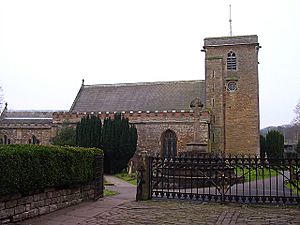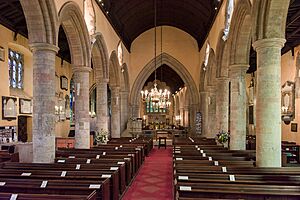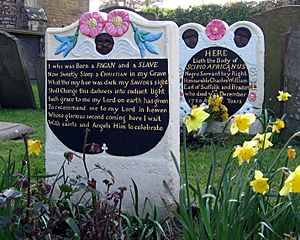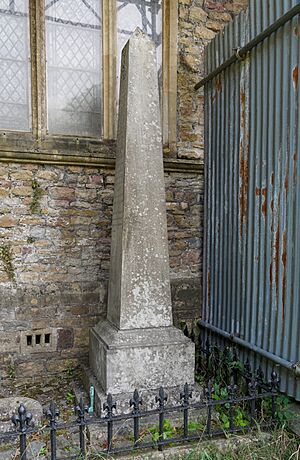St Mary's Church, Henbury facts for kids
Quick facts for kids St Mary's Church, Henbury |
|
|---|---|
 |
|
| Religion | |
| Affiliation | Church of England |
| District | Henbury |
| Ecclesiastical or organizational status | Parish church |
| Location | |
| Location | Bristol, England |
| Architecture | |
| Architectural style | English Gothic |
| Completed | 1300 |
| Website | |
| St Mary's | |
St Mary the Virgin is a Church of England church located in Henbury, Bristol, England.
People think there might have been a church here since the 600s. The church you see today was built in the 1200s. Later, in the 1800s, architects Thomas Rickman and George Edmund Street helped restore it. This church is very important, so it's listed as a Grade II* historic building by English Heritage.
Contents
A Look Back: The Church's History
The very first church on this spot might have been built around the year 691 or 692. This was when King Æthelred of Mercia gave land to Oftfor, who was the Bishop of Worcester.
Around 1093, another Bishop of Worcester, named Wulfstan, gave the Henbury church and its tithes (a type of payment) to Westbury on Trym's monastery. Wulfstan had recently taken over this monastery for the Worcester diocese.
From Monastery to College
When the monastery became Westbury College around 1194, the area around Henbury became a "prebend" of the college. This meant the money from Henbury's tithes helped pay for one of the college's canons. This canon was in charge of finding a vicar (a type of priest) for St Mary's Church.
St Mary's Church was also one of two churches that the college community was responsible for keeping up. The other was Holy Trinity Church, Westbury on Trym.
Bishops from the Worcester diocese would visit the college regularly to check on things. They had a special palace in Henbury where they would stay. This palace was near St Mary's, but its exact location is not known today.
Becoming a Parish Church
In 1544, Westbury College was closed down. After this, St Mary's became a regular parish church for the new Bristol diocese.
Church Records and Archives
Important records for St Mary's Church are kept at Bristol Archives. These include lists of baptisms, marriages, and burials.
The archives also have records about the church leaders, churchwardens, and local charities. You can also find old plans, deeds, and photographs of the church there.
The Church's Design and Architecture
The main part of the church, called the nave, and the lower part of the tower were built around the year 1200. In the early 1200s, the upper part of the tower, the chancel (the area around the altar), and the south chapel were added.
Around 1300, the clerestory (a row of windows high up) was built. These parts show the Early English style, even though they have been repaired since. Look for the old Late Norman doorways, which have rounded arches.
Later Changes and Restorations
In 1836, Thomas Rickman built the north chapel and did some repair work on the church. Later, from 1875 to 1877, George Edmund Street restored the church even more.
These 19th-century restorations added features from the Perpendicular Gothic Revival style. You can see these in the windows of the nave and the chapels.
In the churchyard, there is a small building called a mortuary chapel. It was built around 1830 and might also have been designed by Rickman. It is also a listed historic building.
Important Memorials and Graves
In the churchyard, you can find the grave of a person known as Scipio Africanus. He was a slave, and his grave has a special headstone and footstone that are painted. It dates back to 1720 and is also a listed historic site.
An obelisk (a tall, thin monument) with a stone ankh (an ancient Egyptian symbol) marks the grave of Amelia Edwards. She was an Egyptologist, someone who studies ancient Egypt. She is buried with her friend, Ellen Drew Braysher, and Ellen's daughter, Sarah Harriet. In 2016, Historic England made this grave a listed site. It is important for English LGBT history.
The churchyard also holds the grave of Philip Napier Miles. He was a kind person who helped others and was the last "squire" of King's Weston. He passed away in 1935.
There are also war graves in the churchyard. These are for soldiers who died in the First World War and the Second World War.
See Also
- List of churches in Bristol
- Grade II* listed buildings in Bristol





